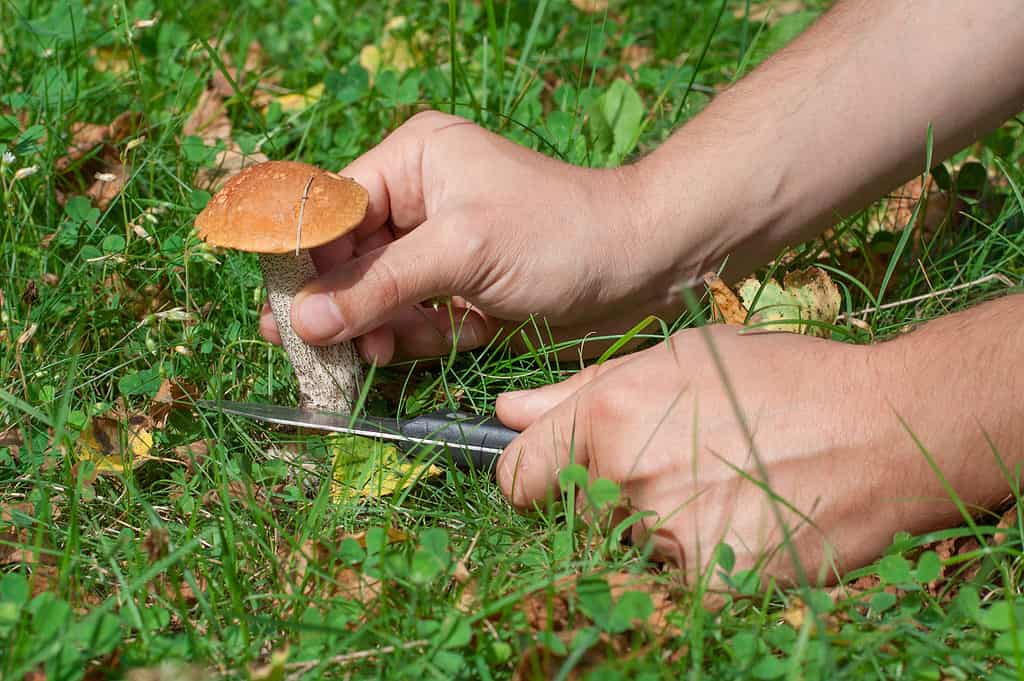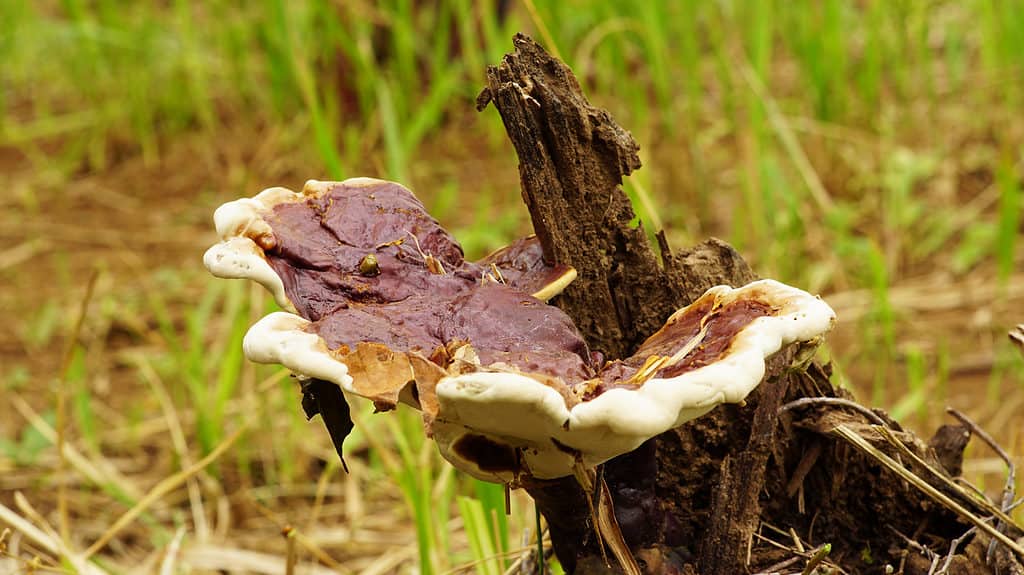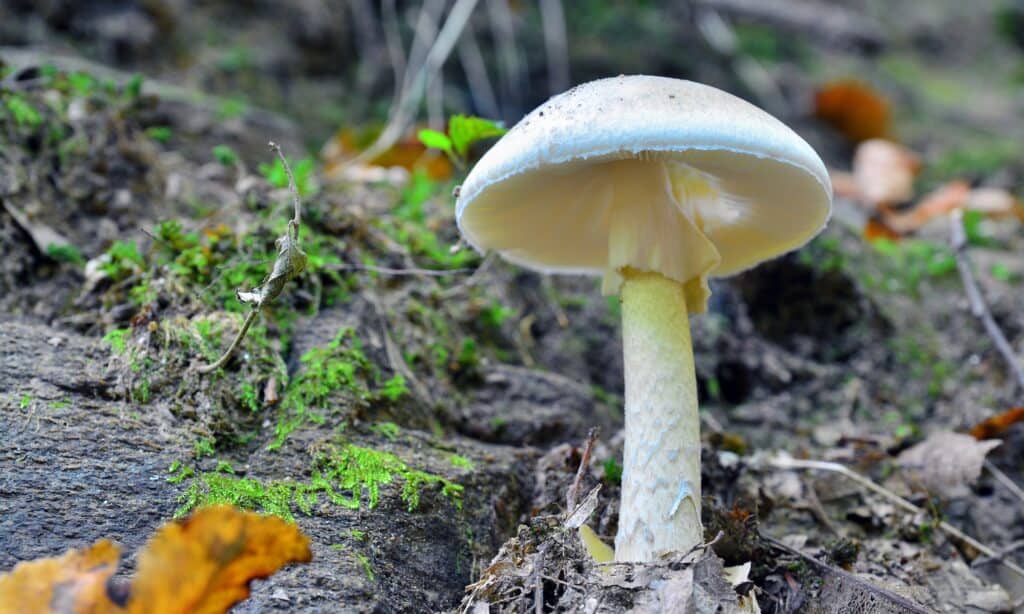In Oklahoma, hunting and fishing are popular hobbies but there’s another kind of hunting that’s less popular- mushroom hunting! While mushroom hunting is becoming a more mainstream hobby, people have been foraging for mushrooms in Oklahoma for many years now.
Often when people talk about mushroom hunting, they’re talking about the Pacific Northwest but Oklahoma has rich land for mushroom growth! This diverse land between the Rockies and the Ozarks has many dense forests that can support mushrooms.
Learning to forage for mushrooms can be beneficial in many ways. You can learn about native species, explore local natural areas, meet “mushroomers”, and (eventually) come home with fresh mushrooms!
Keep reading to learn about the edible mushroom species that can be found in Oklahoma, where to go hunting, and much more!

People have been foraging for mushrooms in Oklahoma for many years now.
©encierro/Shutterstock.com
Getting Started
It might seem intimidating at first if you don’t know anything about mushrooms and you’re worried about picking a toxic one. That’s understandable because there’s a whole lot of mushrooms to learn about! Even mycologists, people who study mushrooms, are learning new things all the time.
Don’t let this be an obstacle for you but instead, know that mushroom hunting is something you can learn about all of your life! For us “mushroomers” this is super exciting!
It’s very important not to underestimate how deadly some toxic mushrooms are. If you’re going to eat a mushroom you need to be 100% sure of the species before you eat it. If you’re not completely sure, don’t take the risk.
It will take a while to build up your knowledge to be 100% positive of what you find. But, with practice and patience, you slowly become an expert!
Don’t forget that you can take pictures or take the mushroom home to study further. Or, you can simply walk through the forest and take note of mushrooms without picking any. There’s nothing wrong with coming home empty-handed!

It will take a while to build up your knowledge of mushrooms so try taking photos and studying them at home.
©K.Kargona/Shutterstock.com
Resources
In this article, I’ve compiled tons of information about mushroom species and mushroom hunting in Oklahoma, but there’s always more. It’s important to read through various sources to soak in as much information as you can.
Mushroom Observer is a great website used all over the country as both an informational source and an online place to share your findings. It’s free to register and once you do, you can access their huge compilation of data and pictures about mushrooms!
It’s also a great idea to join a mushroom-hunting group. By joining a group you can meet other mushroom hunters – experienced and amateur – go on guided walks, and learn about local spots.
Mushroom hunting is really about gaining knowledge through experience. So, as a beginner, the best thing you can do is to listen and learn from those who have been going for years.
The Oklahoma Mycological Society connects mushroom hunters from all over the state to share with each other. Another platform for meeting and exchanging tips is the Oklahoma Wild Mushrooms Enthusiasts Facebook group.
Rules and Regulations
Before you zealously head out into the forest ready to collect some mushrooms, it’s important to know where you can and can’t go, and the requirements for each place.
In Oklahoma, collecting mushrooms in state parks is prohibited. In the Chickasaw National Recreation Area, you’re allowed to collect up to 5 gallons of mushrooms, per person per year.
Lands managed by the Oklahoma Department of Wildlife Conservation are open to mushroom hunters with a hunting-fishing permit. To collect mushrooms on any private property you need to have explicit permission from the owner. Of course, this means you can collect mushrooms on your own property!
Regulation can change seasonally and, evidently, turkey season has a large influence on whether lands are open. To be sure, double-check the requirements on the website or call the office number for the specific place you’re going to.
General Foraging Tips
Here are a few tips to help you be more prepared when you go mushroom hunting. Also, some general foraging etiquette so that you’re responsible and respectful.
The main rule is to only take as much as you need. This can be hard to gauge sometimes, but be reasonable. Take as much as you’ll actually eat and leave the rest for other mushroom hunters and forest animals that are looking for something to eat!
It helps to “tap the cap” to release the spores. Some also recommend carrying mushrooms in a mesh bag or wicker basket so that the spores can fall as you walk around. The distribution of spores helps support new mushroom growth. Sometimes we find a young mushroom that hasn’t yet released its spores so these practices are to make sure the spores are still dropped.
Some foragers bring a pocket knife to snip mushrooms and trim off the dirty skin. You should never pre-wash mushrooms because the extra moisture will cause them to wilt. It’s better to cut or brush off the dirt.
Lastly, keep your eyes open! Mushrooms often grow together or near the same tree, so if you see one there are likely more! Also, once you find a mushroom don’t get so fixated because there could be snakes or other wild animals around.

Some foragers bring a pocket knife to snip mushrooms and trim off the dirty skin.
©iStock.com/siaivo
Common Edible Mushrooms
Thankfully, there aren’t many mushrooms with super high amounts of toxins, but this doesn’t mean that most mushrooms are edible. There are only a handful of mushrooms that are both safe to eat and tasty. These are called “choice edibles” and these mushrooms are the ones you’ll want to search for.
Something to keep in mind is that you always need to cook any wild mushrooms you find. Even well-known edible mushrooms need to be cooked, as they can still contain toxins in their raw form.
Here is a short list of three easy-to-find and useful mushrooms but for a comprehensive list of edible mushrooms in Oklahoma, see this page.
Morel mushrooms (Morchella spp.)
Morel mushrooms are loved by mushroom hunters everywhere they can be found! They have a unique nutty flavor and a meat-like texture when cooked. They’re considered one of the top edible mushrooms in the world – by chefs and foragers alike – and are one of the most commonly foraged mushrooms in Oklahoma.
The name “morel mushroom” refers to many species in the Morchella genus but specifically, Morchella americana is often found in Oklahoma. In any case, all morel mushrooms are edible when cooked!
Aside from their great flavor, morel mushrooms are foraged because they’re quite easy to identify. They have a unique cap with deep ridges that resembles a honeycomb. However, these mushrooms are small and aren’t easy to spot.
Morels are “in season” in the spring, once temperatures warm up. These mushrooms prefer warmer climates and need lots of moisture, so spring showers typically trigger morel mushrooms. They start to appear in March in Oklahoma and can be found through May.
As long as the temperatures are in the 60’s and 70’s and there’s plenty of moisture, it’s morel time! For even more information about morels in Oklahoma, check out the Oklahoma Morel Report by Marty Lee.

Morels are one of the most commonly foraged mushrooms in Oklahoma.
©Mircea Costina/Shutterstock.com
Chicken of the Woods (Laetiporus sulphureus, Laetiporus conifericola, Laetiporus gilbertsonii)
This mushroom is literally called chicken of the woods, partially because of its bright orange color but mostly because, well, it tastes like chicken! It’s sometimes called “sulphur shelf” as well, but that’s much less appetizing.
Chicken of the woods is used to refer to all three of these species of Laetiporus, with the main difference being that each species has a different habitat.
These mushrooms are all super tasty and can be prepared in many ways. However, note that they must be completely cooked. All cases of indigestion from eating chicken of the woods have come from eating a raw or undercooked piece, or a mushroom that was too old.
The best way to tell the age of chicken of the woods is its color. When they first emerge, they’re pale or light yellow and a mature chicken of the woods is bright orange before becoming dark orange and very tough.
The younger specimens are softer and therefore have a better texture when cooked, while the older ones are drier and eventually become crumbly when they’re very old. The young mushrooms appear glob-shaped but as they age, the caps spread out horizontally and the mushroom flattens.
Chicken of the woods is a decomposer, so it can be found on dead or decaying wood pieces. Most often, they’re found on hardwoods like oak, poplar, aspen, or beech trees. Laetiporus conifericola grows on conifer trees and Laetiporus gilbertsonii grows more often on oak or eucalyptus trees.

Chicken of the woods is a decomposer, so it can be found on dead or decaying wood pieces.
©nomis_h/Shutterstock.com
Reishi (Ganoderma sessile, Ganoderma lucidum)
Reishi isn’t used as often in the kitchen, but it’s been shown to have a highly positive effect on the immune system. There are many species of reishi mushrooms all around the world, but G. sessile and G. lucidum are the species you’re most likely to find in Oklahoma. There are minimal differences between the different species and they’re all believed to have the same healing properties.
Reishi mushrooms are fairly easy to identify and they don’t have any toxic lookalikes! They have little to no stem and grow horizontally out of dead wood. The center of the cap is dark red then fades outward to dark then lighter orange with white edges. Reishi mushrooms have a shiny – but not sticky – finish.
These mushrooms don’t have gills and the underside is flat and white. The underside becomes gray or tan with age, you want to avoid these since they’re less fresh. Ideally, you want a firm reishi with a white underside that bruises to tan when pressed.
An exciting thing to note about reishi mushrooms is that they fruit annually on the same piece of wood. This means that if you find some growing, you can return the next year and find more until that piece of wood has been consumed.
Reishi mushrooms decompose pieces of hardwood, most often from oak trees. They begin to fruit in the spring and grow quickly, so it’s best to go out daily if you’re hunting these!

The Ganoderma sessile (reishi) mushroom has a cap that is dark red at the center fading outward to dark then lighter orange with white edges.
©iStock.com/wahid hasyim asyari
Common Toxic Mushrooms
Along with studying some basic edible mushrooms, you should know how to identify the highly toxic mushrooms. This way, you can have a clearer idea of which mushrooms to be going for and which ones to stay away from!
False Morel (Gyromitra esculenta, Gyromitra montana)
A perfect example of the need to study both is Gyromitra esculenta or the false morel. It can be tricky for novice hunters to distinguish the two, but once you learn to recognize true and false morels, you’ll find that they don’t look much alike.
These mushrooms are also called “beefsteak” or “brain” mushrooms because their cap has ridges like ground beef or a brain does. This is where hunters confuse them but with more experience you’ll notice the differences.
One easy way to tell the two apart is to cut one open. True Morels are hollow inside while false morels are not. Also, false morels are typically lower to the ground and grow in a more rounded or flat way. Morels grow upright and have a vertical posture.

One easy way to tell a true morel from a false morel is to cut one open since true morels are hollow inside.
©iStock.com/Helin Loik-Tomson
Death Cap (Amanita phalloides)
The “death cap” is one to know well because it does not live down to its name. This mushroom, Amanita phalloides, is one of the most toxic of its genus and in the world.
The death cap is a large mushroom and impressive mushroom. However, when it emerges from underground it goes through an egg phase where it’s small and rounded.
These mushrooms are completely white – both their stipe and stem – however their caps can be yellow- or green-tinted. On the underside, they have long and elegant white gills. They grow individually and strongly contrast the dark forest floor.
Death cap mushrooms often grow with hardwood trees, particularly near oaks. They tend to grow in late summer and fall after frequent rains.

The death cap is considered to be one of the most poisonous mushrooms in the world.
©iStock.com/empire331
Where to Go Mushroom Hunting
Of course, mushrooms don’t have a sign overhead that says “pick me!” and they’re not always easy to spot. That’s why it’s called mushroom hunting and not mushroom picking.
Lots of mushrooms are only a few inches tall, which pales in comparison to trees that are over 60 feet tall. So, when you’re in the forest it can be easy to feel like you don’t see anything – but I assure you, there are fungi to be found!
With experience, you’ll learn where and how to look for mushrooms. Keep your eyes down on the ground right around you, searching for any small mushrooms peeping out from the leaves on the forest floor. However, raking away leaves and digging up plants to search for mushrooms is a destructive practice that harms the forest ecosystem.
The best way to search for mushrooms is to do research based on species. Every mushroom has its native habitat. It’s much easier to go hunting for one or two species that are in season than to try to identify every mushroom you find.

When mushroom hunting keep your eyes down on the ground to spot mushrooms peeping out from the leaves on the forest floor.
©Grusho Anna/Shutterstock.com
When to Go Mushroom Hunting
In general, spring through fall months are when you can go mushroom hunting. But this varies a ton depending on the species and the weather conditions.
Just as every mushroom has its habitat, it also has a specific season. Most species are either spring or fall mushrooms. But, some continue to grow during the summer, some grow in the winter, and some mushrooms grow all year round!
Typically, mushrooms grow in temperate conditions, so the mild temperatures of spring and fall tend to be best. What’s most important, though, is that there’s enough moisture in the air. Many mushrooms can grow throughout the summer as long as it doesn’t become too dry.
Each species of mushroom has its own specific preferences hat determine when the mushroom will sprout – or if they will at all! Along with temperatures and moisture levels, some mushrooms need the soil to be warm or to be protected from direct sun.
There are many factors and even expert mushroom hunters can’t always predict the season. Regardless, by researching one or two species in particular, you can make sure you’re at least going the right time of year.
Let the Hunt Begin!
So, do you feel like a mushroom expert that knows everything about Oklahoma mushrooms? Probably not – and that’s okay! First off, you can’t become an expert after reading a few articles but secondly, you don’t need to be an expert to begin!
The experts in the field have been out studying mushrooms for years and are still learning and finding new mushrooms. You certainly don’t have to study for years before you ever go out hunting.
Connecting with experienced hunters in your area is a fantastic way to gain knowledge with very little experience and gain confidence to start going out foraging for mushrooms. Good luck and happy hunting!
Up Next
- Discover 10+ Different Types of Wild, Edible Mushrooms
- 8 Different Types of Poisonous Mushrooms You Should Avoid
- What is the Best Month for Mushroom Hunting?
The photo featured at the top of this post is © iStock.com/dolgachov
The information presented on or through the Website is made available solely for general informational purposes. We do not warrant the accuracy, completeness, or usefulness of this information. Any reliance you place on such information is strictly at your own risk. We disclaim all liability and responsibility arising from any reliance placed on such materials by you or any other visitor to the Website, or by anyone who may be informed of any of its contents. None of the statements or claims on the Website should be taken as medical advice, health advice, or as confirmation that a plant, fungus, or other item is safe for consumption or will provide any health benefits. Anyone considering the health benefits of particular plant, fungus, or other item should first consult with a doctor or other medical professional. The statements made within this Website have not been evaluated by the Food and Drug Administration. These statements are not intended to diagnose, treat, cure or prevent any disease.
Sources
- Oklahoma Fungi, Available here: https://www.oklahomafungi.com/post/foraging-for-fungi
- Porches and Pastures , Available here: https://www.porchesandpastures.com/porch-talk/morel-mushroom-hunting-in-oklahoma
- Oklahoma Wildcrafting , Available here: https://www.oklahomawildcrafting.com/mushrooms
- Healing Mushrooms , Available here: https://healing-mushrooms.net/oklahoma
- Mushroom Observer , Available here: https://mushroomobserver.org/
Thank you for reading! Have some feedback for us? Contact the AZ Animals editorial team.







